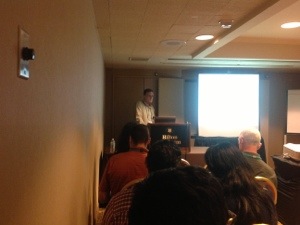 Emerson’s Pete Sharpe presented on the subject of fired heaters. His abstract [hyperlink added]:
Emerson’s Pete Sharpe presented on the subject of fired heaters. His abstract [hyperlink added]:
The newly revised API’s RP 556, is a collection of best practices for fired heater instrumentation, control and protective systems. Emerson can go beyond performing a gap analysis between existing instrumentation and control and the new recommendations. Advanced process control methods coupled with a solid combustion control strategy provides an effective means of safely operating near constraints, allowing users to control to a target combined coil outlet temperature while minimizing energy cost, emissions and overall variability.
Pete opened by crediting Emerson’s Gary Hawkins and Nikki Bishop for their input into the session content.
Fired heaters are used across many industries. They come in many configurations for air control, fuel sources, heating and vaporization characteristics. The API RP556 defines recommended practice for instrumentation, control, and safety shutdown for a process fired heater. Pete pointed out that these are not required but recommended. It’s not prescriptive by law or code.
Instrumentation includes temperatures, pressures, flows, analyzers for combustion and fuel gas heating value, and safety-related–flame detection, interlocks, safety instrumented system, lightoff sequences, and emergency shutdowns.
The typical control objectives include reduce variability to operate safely near constraints, handle disturbances, reduce thermal stress, and eliminating hot spots. Next it’s important to operate within limits to maximize time between decoking, maximizing charge and yields. Also, objectives are around minimizing energy costs and emissions to meet regulatory requirements.
The whole idea of reducing variability is to be able to operate closer to constraints to improve the overall profitability of the process. Two things we want to control are the charge to the heater (feed rate) and the combustion process. Adjusting the air flow is a large lever on combustion control. Their is an optimum point where of fuel and air for maximum efficiency.
If you can reduce stack O2 5%, you improve efficiency 2 1/2% (2 to 1 ratio rule of thumb). Controlling temperature by fuel flow rate is variable based upon BTU per standard cubic foot. Using Coriolis mass-based measurement is the way to avoid this variability. A cross limiting strategy is used for combustion control. Based on demand, air consumption is changed which in turn changes the fuel consumption.
To use advanced control, embedded model predictive control is used in a DeltaV controller. The application requires high-speed, redundant control to balance temperature while optimizing the air-fuel mixture. These fired heater advanced controls have been put together into a pre-engineered fired heater solution to reduce installation and commissioning times.
